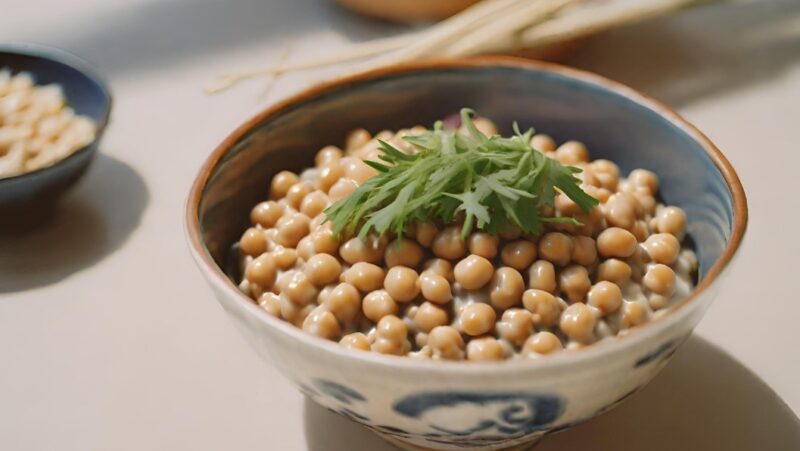Hey there, fellow foodies and adventurous eaters! If you’ve ever been on a culinary journey, you know that sometimes the most intriguing dishes come in unexpected packages. Today, we’re taking a deep dive into the world of natto, the mysterious and beloved Japanese delicacy.
You might have heard about it, seen it in photos, or even plucked up the courage to try it yourself. But what does natto actually taste like? Buckle up because we’re about to uncover the secrets of this sticky, savory, and slightly strange dish.
The Initial Sensory Experience

The first encounter with natto can be quite striking. It has a distinctive, pungent aroma that is often described as earthy, somewhat akin to a strong cheese. This smell is a direct result of the fermentation process and is a good indicator of the complex flavors that follow. The appearance of natto is also notable, with its small beans coated in a sticky, stringy slime that can be off-putting for first-timers.
Here are some popular Natto dishes to try:
| Dish Name | Description |
|---|---|
| Natto Rice | A classic and simple dish where natto is mixed with steamed rice and often seasoned with soy sauce, green onions, and sometimes raw egg. |
| Natto Sushi | Natto can be used as a sushi topping, providing a unique and savory addition to traditional sushi rolls or nigiri. |
| Natto Toast | Spread natto on toast for a quick and nutritious breakfast or snack. You can add toppings like avocado, cheese, or vegetables for extra flavor. |
| Natto Salad | Incorporate natto into a salad with fresh greens, tomatoes, and your favorite salad dressing for a healthy and flavorful option. |
| Natto Omelette | Add natto to your morning omelette for a protein-packed and umami-rich breakfast. You can include vegetables and cheese for added taste. |
| Natto Stir-Fry | Use natto as an ingredient in a stir-fry with vegetables, tofu, and your choice of sauce for a delicious and hearty meal. |
| Natto Pasta | Mix natto into cooked pasta, along with garlic, olive oil, and parmesan cheese for a fusion of Japanese and Italian flavors. |
| Natto Miso Soup | Enhance your miso soup by stirring in natto. The fermented beans add a unique twist to this traditional Japanese soup. |
| Natto Kimchi | Combine natto with Korean kimchi for a spicy and tangy dish that’s a fusion of Japanese and Korean flavors. |
| Natto Pizza | Experiment with natto as a pizza topping. Pair it with ingredients like bacon, mushrooms, and cheese for a savory pizza experience. |
The Taste Profile
Natto’s flavor is as complex as its aroma. It has a strong, savory taste, often described as nutty and slightly yeasty. There’s a certain umami quality to natto, a depth of flavor that can be attributed to the fermentation process. This umami aspect makes it pair well with other strong flavors like soy sauce and mustard.
Natto also has a subtle bitterness, which varies depending on the fermentation duration and the type of soybeans used. This bitterness is not overwhelming but adds to the complexity of the dish. There’s also a hint of sweetness, which provides a balance to the overall taste profile.
Texture: An Integral Part of the Experience

The texture of natto is as important as its taste. The slimy, gooey consistency is a result of the polysaccharides produced during fermentation. When stirred, natto develops more stickiness, creating long, cheese-like strands that are a hallmark of the dish. The beans themselves are tender and can be easily mashed with a slight pressure. This unique texture plays a significant role in the overall sensory experience of eating natto.
The Aftertaste and Mouthfeel
After consuming natto, the flavors linger in the mouth, providing a long, savory aftertaste. This aftertaste is often described as earthy and can stay for a while, a characteristic appreciated by natto enthusiasts. The mouthfeel of natto is unique; the stickiness can coat the mouth, emphasizing the lingering flavors.
Polysaccharides and Stickiness:

The slimy and gooey texture of natto is a distinctive characteristic that often surprises first-time tasters. This texture is primarily attributed to the presence of polysaccharides, which are complex carbohydrates formed during the fermentation process. These polysaccharides create a viscous and sticky matrix that surrounds the soybeans.
When you first open a pack of natto, you’ll notice a thin, translucent layer of slime covering the beans. This layer can be quite stretchy, and it’s one of the defining features of natto’s texture. When you begin to stir natto vigorously, these polysaccharides become more pronounced, leading to the formation of long, cheese-like strands. This unique property is often referred to as “neba-neba,” a Japanese term that describes the slimy and sticky texture.
Tenderness of Soybeans:
While the exterior of natto is characterized by its sliminess, the soybeans themselves offer a contrasting texture. They are tender and soft, with a creamy consistency that can be easily mashed with a slight pressure from your utensil or even your tongue. This combination of slimy coating and soft interior creates a textural interplay that some find intriguing and others find challenging.
Sensory Contrast:

The contrasting textures of natto play a crucial role in the overall sensory experience. As you take a bite, you’ll first encounter the slightly chewy and sticky outer layer, which gives way to the creamy and tender soybeans inside. This contrast is not only tactile but also contributes to the overall flavor perception. The sticky coating serves as a vehicle for the flavors, allowing them to linger in your mouth and enhancing the taste experience.
FAQs
Final Words
In conclusion, natto is an enigmatic dish with a complex, robust flavor profile. Its taste is a combination of savory, nutty, and slightly sweet and bitter notes, complemented by a unique sticky texture. While natto might not be for everyone, its depth of flavor and health benefits make it a fascinating subject in the culinary world and a must-try for those adventurous in taste.
